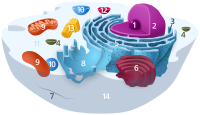
Photo from wikipedia
The endoplasmic reticulum (ER)-localized Hsp70 chaperone, BiP, undergoes a rapid, reversible and inactivating post-translational modification. This covalent modification complements the slower, conventional unfolded protein response (UPR) in matching the supply… Click to show full abstract
The endoplasmic reticulum (ER)-localized Hsp70 chaperone, BiP, undergoes a rapid, reversible and inactivating post-translational modification. This covalent modification complements the slower, conventional unfolded protein response (UPR) in matching the supply of active Hsp70 chaperone to the protein folding demand within the ER lumen. Long believed to be ADP-ribosylation, we now know this modification to be AMPylation (adenylylation) of BiP's threonine 518. Here, we review the discovery of the responsible enzyme (the Fic domain-containing protein FICD), the structural and biochemical basis of the inactivating modification and the discovery of FICD's dual role as the enzyme that both AMPylates and deAMPylates BiP. The structural basis of BiP recognition by FICD and recent in vitro insights into oligomeric state-mediated regulation of FICD's antagonistic enzymatic activities are also reviewed, the latter in the context of how such a regulatory system may arise in cells. Last, we consider the physiological significance of BiP AMPylation and speculate on the fitness benefits of this metazoan-specific adaptation.
Journal Title: Cold Spring Harbor perspectives in biology
Year Published: 2022
Link to full text (if available)
Share on Social Media: Sign Up to like & get
recommendations!